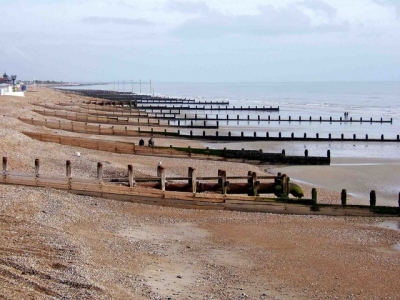
|
Man-made, shore protection measures to reduce erosion. Constructed of wood or stone, groynes control the movement of water rushing onto the beach and prevent sand from being swept away by the waves. A number of groynes usually run perpendicular to the shore and extend up to the sea. |
A groyne is a rigid hydraulic structure built perpendicularly from an ocean shore (in coastal engineering) or a river bank, interrupting water flow and limiting the movement of sediment. It is usually made out of wood, concrete, or stone. In the ocean, groynes create beaches, prevent beach erosion caused by longshore drift where this is the dominant process and facilitate beach nourishment. There is also often cross-shore movement which if longer than the groyne will limit its effectiveness. In a river, groynes slow down the process of erosion and prevent ice-jamming, which in turn aids navigation.
Groynes run generally perpendicular to the shore, extending from the upper foreshore or beach into the water. All of a groyne may be underwater, in which case it is a submerged groyne. They are often used in tandem with seawalls and other coastal engineering features. Groynes, however, may cause a shoreline to be perceived as unnatural. Groynes are generally straight but could be of various plan view shapes, permeable or impermeable, built from various materials such as wood, sand, stone rubble, or gabion, etc.
Credit: Wikipedia
Picture Credit : Google




